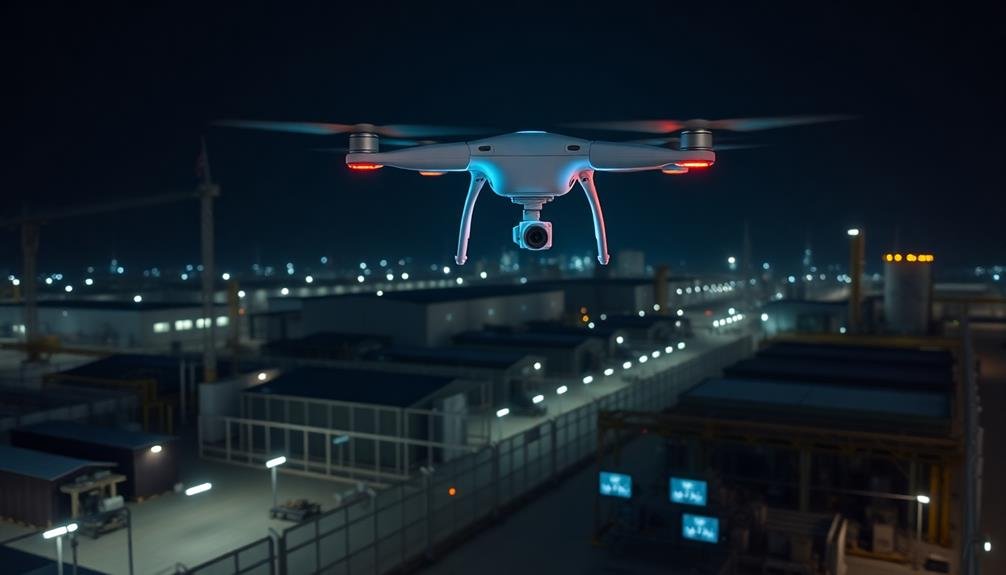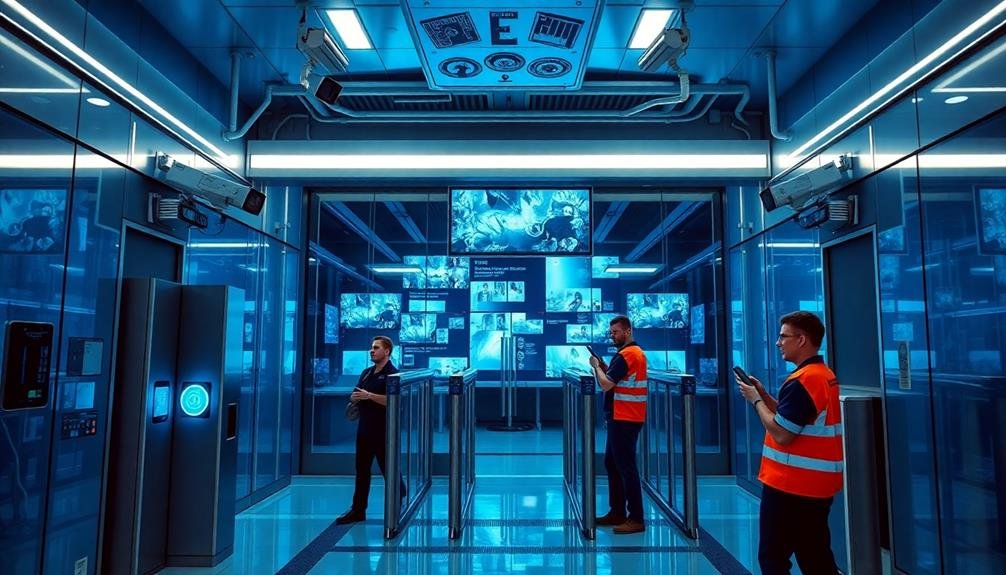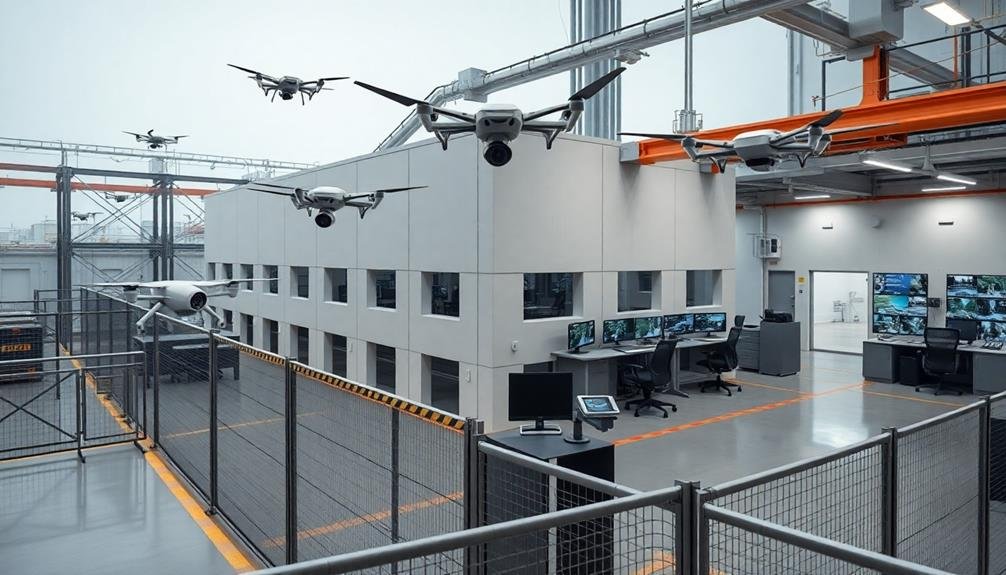For industrial facilities, three top automated security solutions stand out. Automated drone surveillance systems offer real-time monitoring and rapid response, covering large areas quickly. AI-powered perimeter monitoring uses machine learning to analyze video feeds, detect threats, and reduce false alarms. Smart access control integration enhances security through biometric verification and real-time logging of entry and exit activities. These cutting-edge solutions provide extensive protection for your assets, personnel, and sensitive information. By implementing these automated systems, you'll greatly boost your facility's security while reducing costs and human error. Dive deeper to discover how these technologies can revolutionize your industrial security approach.
Key Takeaways
- Automated drone surveillance systems provide cost-effective, real-time monitoring and rapid response for large industrial areas.
- AI-powered perimeter monitoring offers 24/7 threat detection and classification, reducing false alarms and enhancing security effectiveness.
- Smart access control integration ensures secure identity verification and real-time monitoring of entry/exit activities in industrial facilities.
- Thermal imaging cameras combined with AI analytics enable accurate threat detection in low-light conditions and challenging environments.
- Integrated security management systems coordinate multiple automated solutions for comprehensive industrial facility protection.
Automated Drone Surveillance Systems

Soaring above industrial complexes, automated drone surveillance systems have revolutionized security measures. These unmanned aerial vehicles offer a bird's-eye view of your facility, providing real-time monitoring and rapid response capabilities.
You'll benefit from their ability to cover large areas quickly, accessing hard-to-reach locations that traditional security methods can't. Equipped with high-resolution cameras and thermal imaging, these drones can detect intruders, identify potential threats, and monitor for safety hazards 24/7.
They're programmed to follow predetermined flight paths or respond to specific triggers, ensuring consistent coverage of your property. You'll appreciate the cost-effectiveness of drone systems compared to installing extensive camera networks or hiring additional security personnel.
They're also adaptable, allowing you to easily modify surveillance patterns as your facility's needs change. Integration with your existing security infrastructure is seamless. Drones can relay data directly to your control center, enabling quick decision-making and coordinated responses.
They're particularly useful for perimeter security, asset protection, and emergency situation assessment. However, you'll need to take into account regulations, privacy concerns, and potential interference with operations when implementing drone surveillance.
Proper planning and compliance are essential for successful deployment.
AI-Powered Perimeter Monitoring

The outer boundary of your industrial facility is your first line of defense, and AI-powered perimeter monitoring systems are transforming how it's secured. These advanced systems use machine learning algorithms to analyze video feeds from cameras strategically placed around your facility's perimeter. They can detect and classify potential threats in real-time, distinguishing between humans, vehicles, and animals, while filtering out false alarms caused by environmental factors.
AI-powered perimeter monitoring offers several key advantages:
- Continuous 24/7 surveillance without human fatigue
- Instant alerts to security personnel when genuine threats are detected
- Reduced false alarms, saving time and resources
You'll find that these systems can integrate seamlessly with your existing security infrastructure, enhancing overall effectiveness. They're capable of tracking multiple objects simultaneously, predicting potential security breaches based on behavior patterns, and even recognizing specific individuals or vehicles of interest.
As AI technology continues to advance, these systems become increasingly accurate and efficient, providing you with a robust, proactive approach to perimeter security. By implementing AI-powered perimeter monitoring, you're not just protecting your facility; you're staying ahead of potential threats in an ever-evolving security landscape.
Smart Access Control Integration

Building on the foundation of AI-powered perimeter monitoring, smart access control integration takes your industrial facility's security to the next level. You'll streamline entry processes while maintaining rigorous security standards. Smart access control systems use biometric data, RFID cards, or mobile credentials to verify identities quickly and accurately.
These systems offer real-time monitoring and logging of all entry and exit activities. You can easily manage access permissions, revoke credentials instantly, and generate detailed reports. Integration with your existing security infrastructure allows for a thorough, coordinated approach to facility protection.
Here's a breakdown of smart access control benefits:
| Feature | Benefit |
|---|---|
| Biometric Authentication | Enhanced security, eliminates credential sharing |
| Mobile Access | Convenient, reduces physical card management |
| Real-time Monitoring | Immediate threat detection and response |
| Integration Capabilities | Seamless coordination with other security systems |
Frequently Asked Questions
How Much Do Automated Security Solutions Typically Cost for Industrial Facilities?
You'll find costs vary widely, but typically range from $10,000 to $500,000+. It depends on your facility's size, complexity, and specific needs. Factors like cameras, access control systems, and integration with existing infrastructure all impact the price.
Can These Systems Integrate With Existing Legacy Security Infrastructure?
Yes, you'll find that many automated security systems can integrate with your existing infrastructure. They're designed to be flexible, allowing you to connect them with legacy equipment like older cameras, access control systems, and alarm panels.
What Are the Privacy Concerns Associated With Implementing Automated Security Solutions?
You'll face privacy concerns with automated security solutions, including data collection, employee monitoring, and potential misuse of information. You should consider strict access controls, data encryption, and clear policies to protect individuals' privacy and comply with regulations.
How Often Do Automated Security Systems Require Maintenance or Software Updates?
You'll need to maintain your automated security systems regularly. They typically require monthly software updates and annual hardware checks. Don't forget to schedule routine inspections, as they're essential for ideal performance and addressing potential vulnerabilities.
Are There Any Regulatory Compliance Issues to Consider When Adopting These Technologies?
You'll need to contemplate regulatory compliance when adopting security technologies. Check local, state, and federal regulations, including data protection laws, privacy standards, and industry-specific requirements. Don't forget to stay updated on evolving compliance rules to avoid penalties.
In Summary
You've now seen three cutting-edge automated security solutions for industrial facilities. By implementing drone surveillance, AI-powered perimeter monitoring, and smart access control, you'll greatly enhance your facility's protection. These technologies work together to create a robust, multilayered security system. Don't hesitate to explore these options further and consult with security experts to determine the best fit for your specific needs. Embrace automation to stay ahead of potential threats and safeguard your industrial assets.

As educators and advocates for responsible drone use, we’re committed to sharing our knowledge and expertise with aspiring aerial photographers.




Leave a Reply